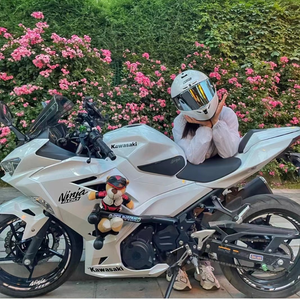Search
₱172.00
₱633.00Save up to 79%
Flash Sale
Buy 2 items to get free gifts
(NEW) HANDLE SWITCH ASSY SET RUSI 125 150 TC 125 TC 150 MOTORCYCLE Accessories 1Pair Left&Right
Sold by Booming Moto
4.8(34)
535 sold
Select options
Select
Shipping
From ₱36.00
Est. delivery by May 13 - May 14
Customer reviews (34)

j**7
Item: BLACK
Good quality ang item... thank you po sa sa seller at delivery...god bless po....


December 15, 2024

A**N
Item: BLACK
Quality product. Very nice..
Material:Goods
Quality of work:👍👍👍


August 2, 2024

#**N g**v
Item: BLACK
Order recieve good salamat seller sana gumagana lahat anu pa hinihontay ikabit nayarn


June 17, 2024

b**g
Item: RUSI-Black
Mganda tong items sna gmagna lhat to! hndi kp nkabit mukang tatagal din...slmat!!!

January 14, 2025

J**l P**a
Item: BLACK
Dumating na ang bilis salamat sa seller at Kay TikTok

August 24, 2024

M**l P**l
Item: BLACK
aus nkabit qoh na mganda at maaus ang item d lang tlaga pwede ung starter bka relay cguro tnx seller..


June 20, 2024

ʋ**a ** ċ**a
Item: RUSI-Black
Thank you Po seller at Kay Kuya delivery rider. dumating napo maayos Po Tama din Po Sabi Ng asawa ko .👍
2w ago

e**n c**g
Item: RUSI-Black
Salamat po sa seller maayos naman po sya sulit ja sulit ang bayad
February 11, 2025

T**8
Item: BLACK
solid sa order good quality😍 order na dka mag sisisi😊
December 20, 2024

T**k N**b
Item: BLACK
Quality of work:quality
Material:goods upon personal
Assembly:nice
September 15, 2024
😔**😔
Item: BLACK
Ok n ok gumagana Sana tumagal salamat sa mura na tinda at thank you sa Rider.
July 14, 2024

R**n
Item: RUSI-Black
Maganda naman.. Di palang naikabit sa motor ko
January 14, 2025

M**n C**g
Item: RUSI-Black
Thank you, satisfied costumer here❤️❤️❤️🥰
March 2, 2025

C**N **
Item: BLACK
Nice..good gumana..sammy po
Thankyou po
September 26, 2024

J**s R**l
Item: BLACK
ayos naikabit ok n s motor kong rusi150
July 16, 2024

R** C**e
Item: BLACK
Ligit d ko pa naikakabit pero maganda
December 8, 2024
N**a
Item: BLACK
Good product and good quality.❤️
July 15, 2024
A**S
Item: RUSI-Black
Ok naman yung all ay gumagana
6d ago

j**n j**y i**a g**n
Item: RUSI-Black
Maganda at mabilis lang
March 18, 2025

r**g
Item: BLACK
Maayos salamat po ⭐⭐⭐⭐⭐
July 9, 2024

Booming Moto
238 items
Shop performance
Better than 90% of other shops
Ships within 2 days
93%
Responds within 24 hours
99%
Product description
"Handle switch" on a motorcycle refers to a set of switch devices installed on the motorcycle's handlebars, used to control various functions and systems of the motorcycle. These switches are typically located on the side or top of the motorcycle handlebars for easy access by the rider while riding. Here's a detailed explanation of common handlebar switches on motorcycles and their functions:
1. Lighting Control
The switches on the handlebars are typically used to control the motorcycle's lighting system, including the headlight, taillight, turn signals, etc. Through the switches on the handlebars, the rider can turn the lights on or off and operate the turn signals to improve visibility and safety while riding.
2. Vehicle Control
Handlebar switches are also commonly used to control basic functions of the motorcycle, such as starting, stopping, throttle, and brakes. For example, the right-hand handlebar typically features controls for the throttle and brakes, while the left-hand handlebar may have buttons or switches for starting and stopping the engine.
3. Accessory Control
Some motorcycles may have additional switches on the handlebars for controlling accessories or auxiliary devices, such as heated grips, horns, electronic cruise control, etc. These switches allow the rider to conveniently operate these features while riding, enhancing comfort and convenience.
4. Information Display
Some motorcycles may have information display screens or indicator lights integrated into the handlebars, showing vehicle status, fault codes, or other important information. Through the switches on the handlebars, the rider can toggle display modes or view specific information to stay informed about the vehicle's operation.







Videos for this product
Paid partnership
AI-generated
Explore more from Booming Moto




4.7
29131sold
₱178.31
₱398.00




4.8
69774sold
₱149.00
₱507.00



4.6
94951sold
₱504.77
₱1,000.00

4.7
101095sold
₱358.86
₱513.00



4.7
49062sold
₱98.00
₱399.00



4.6
28197sold
₱59.00
₱119.00

No more products
Open TikTok










![[SALE NOW!] Street King Motorcycle Side Mirror V3 360 ° Explosion-Proof Anti Dazzling side mirror rusi125 side mirror na pang porma king version 1 king v8 yamaha side adjustable streetking sidemirrorv3 kingside street](https://p16-oec-va.ibyteimg.com/tos-maliva-i-o3syd03w52-us/b763b9ac16e545d88ac28e509e2cdfb8~tplv-o3syd03w52-crop-webp:1200:1200.webp?dr=15592&from=2378011839&idc=maliva&ps=933b5bde&shcp=e1be8f53&shp=8dbd94bf&t=555f072d)


















